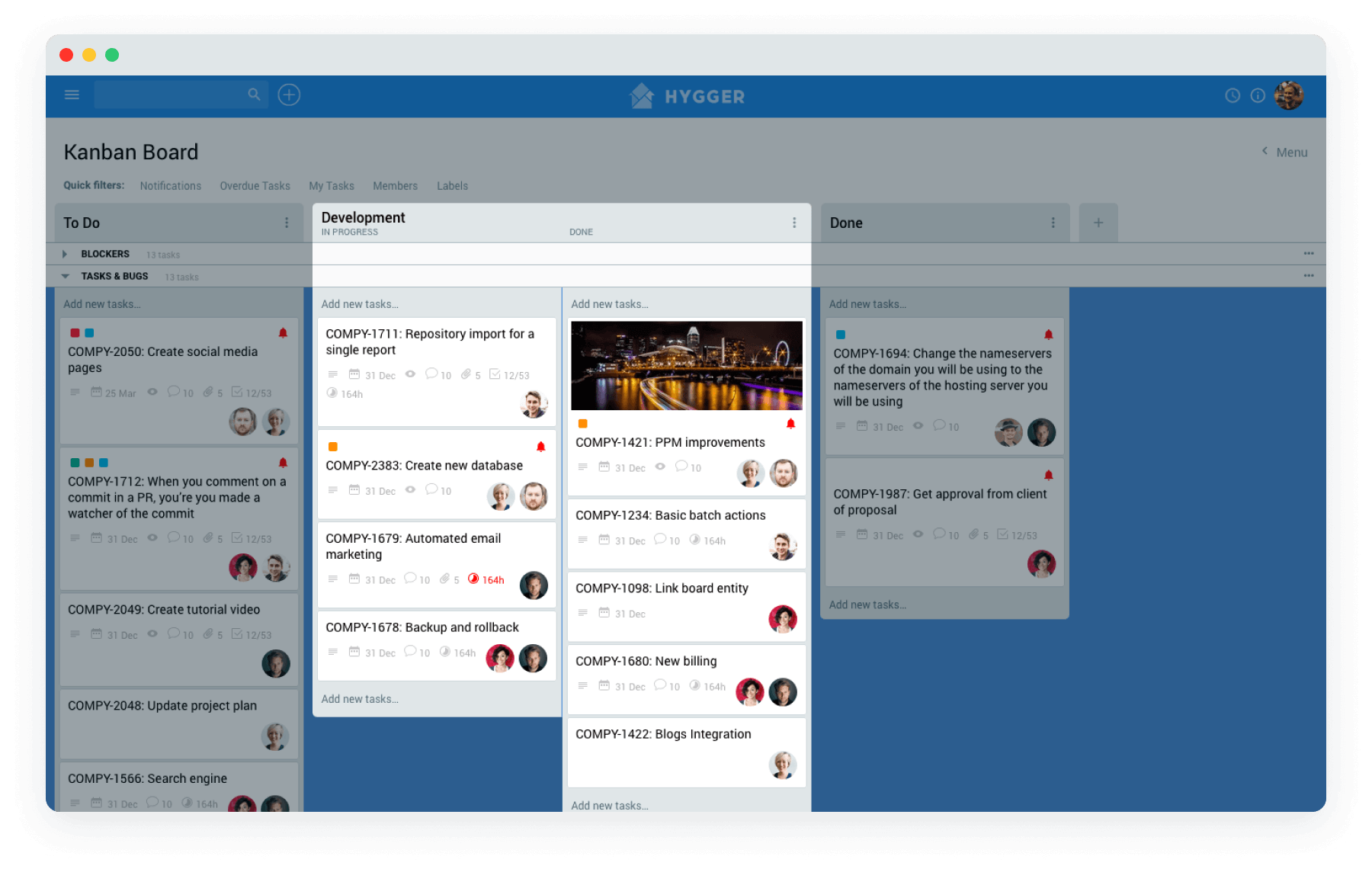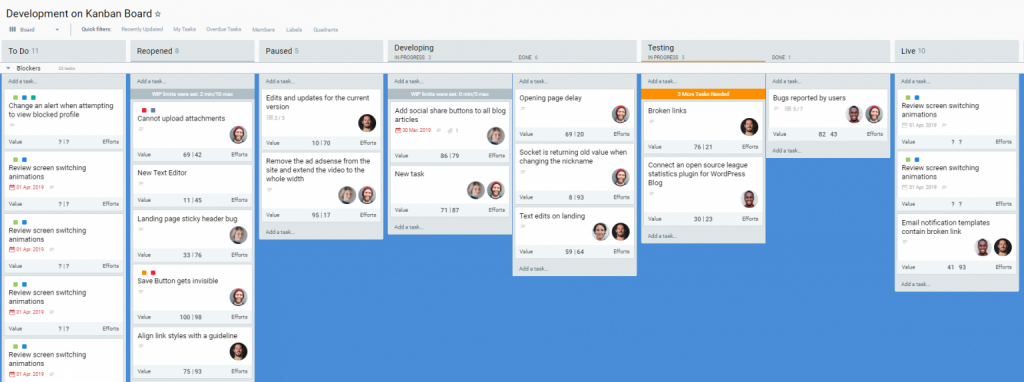Kanban Boards to Boost Work Visibility
Visualize your workflow on digital Kanban Boards and make your team more productive.

Based on 250+ reviews on
What is a Kanban Board?
This visual tool is designed to provide an overview of the current work status and simplify team collaboration.

Main Components of a Kanban Board
To grasp how a Kanban board functions, it’s essential to understand the components it comprises. These elements enable teams to effectively visualize and manage their workflows.

Use Convenient Kanban Boards to Visualize your Workflow From Idea to Implementation

Visualize Your Process on a Kanban Board
An online Kanban board is the core visualization tool for implementing Kanban in your business. It allows you to plot out projects and workflows using columns and cards. The typical Kanban columns are “To Do,” “In Progress,” and “Done.” Commonly used within Agile management, these boards help teams visualize progress and identify blockers.
Recently, Kanban boards have expanded beyond software development and are now used in various areas such as IT, marketing, sales, recruitment, and more. Create beautiful online Kanban boards with Hygger to streamline your processes!
Limit Work in Progress
Multitasking can lead directly to waste and inefficiency, as switching a team’s focus midway can significantly disrupt the process. Kanban aims to maintain a manageable number of active items in progress at any given time.
Implementing a Limiting Work in Progress strategy involves adopting a Pull System across the entire workflow or its components. By limiting the amount of work in progress, it becomes easier to identify inefficiencies in your team’s workflow.


Categorize Tasks Using Swimlanes and Labels
Swimlanes divide a Kanban board horizontally into two or more sections, making them particularly useful for large teams that need to visualize different types of tasks flowing through the work process in addition to the work stages.
With this feature, your ToDoAI Kanban board will remain well-organized and uncluttered, bringing greater clarity to the workflow. Organize tasks on your boards using Swimlanes or Labels to identify blockers and bottlenecks effectively.
Adjust Your Workflow Using Subcolumns
The ability to create sub-columns in Hygger is also incredibly useful. Sub-columns enable you to track task progress more effectively by dividing the processes represented by the columns into two parts: “In Progress” and “Done”.
For instance, if you have a queue of tasks for development, you can set up a composite column called “Development”. Your developers can then take a task from this queue and place it in the “In Progress” sub-column as they begin working on it. Once the task is completed, they can move it to the “Done” sub-column.


Track Time and view reports
ToDoAI facilitates accurate time tracking for swift invoicing and payroll processing. Track the time spent on completed tasks and generate comprehensive reports detailing team members’ activities, project progress, and goals to assess teamwork effectiveness and velocity.
Benefit from user-friendly reports on team performance, costs, budgets, and progress toward project goals. Additionally, ToDoAI provides API access for seamless integration with your existing processes.
Prioritize tasks by Value/Effort
Prioritization enables you to assess and sort tasks based on their importance, allowing you to focus on the most beneficial ones for further development. You can activate Prioritization and select the most suitable method for your situation, or even utilize multiple methods simultaneously. One of the most popular approaches is the Value vs Effort matrix.
Rate your tasks based on their Value/Effort ratio to pinpoint the most critical or risky ones. This helps you make informed decisions on where to allocate limited resources wisely.


Get the balance between Important and Urgent
Utilize the Eisenhower matrix to effectively prioritize your tasks and distinguish between the important and the urgent. Also known as the Urgent/Important Matrix, this tool helps you identify tasks that need immediate attention based on their urgency and importance.
The matrix consists of four quadrants (Do Now, Schedule, Delegate, and Eliminate), which are determined by crossing the axes of “Important – Not important” and “Urgent – Not Urgent”. By using the Eisenhower matrix, you can focus on tasks that will yield significant results in a shorter period of time.
Popular Examples of Using Kanban Boards
Development Team
Utilize the Eisenhower matrix to effectively prioritize your tasks and distinguish between the important and the urgent. Also known as the Urgent/Important Matrix, this tool helps you identify tasks that need immediate attention based on their urgency and importance.
The matrix consists of four quadrants (Do Now, Schedule, Delegate, and Eliminate), which are determined by crossing the axes of “Important – Not important” and “Urgent – Not Urgent”. By using the Eisenhower matrix, you can focus on tasks that will yield significant results in a shorter period of time.


UX Design Team
A Design Kanban board is aimed to create interfaces and experiences for products that will amaze customers.
At ToDoAI the workflow may be like following: Prototype, Implementation, Review, Done.
Product Backlog Board
This kind of board is aimed to organize all the tasks and queues within your product backlog.
At ToDoAI a workflow may look like this: Backlog, Next up, Specification, Development, Done.

What are the Key Benefits of Using Kanban Boards?
Kanban boards assist teams in breaking down projects into manageable tasks and tracking the progress of each task through different stages.
They serve as an effective tool for organizing workflows, assigning and monitoring specific actions, and enhancing communication within teams. Kanban boards offer immediate visual feedback on the project’s progress, making it easier for teams to stay on track. Compared to other Agile project management techniques, Kanban is relatively easy to implement.
However, one drawback of Kanban boards is their focus on tactical project management rather than setting high-level objectives for a project.
Kanban boards:
- Visualize workflows
- Facilitate continuous process improvement
- Increase productivity and efficiency
- Reduce waste and bottlenecks
- Enhance team communication
- Improve project delivery success rates
ToDoAI offers user-friendly online Kanban boards to help teams and organizations coordinate effectively. Create your board now to keep track of all tasks and projects in one place.
Kanban FAQ
Is Kanban Methodology?
Kanban is indeed part of the Agile methodology family, but unlike some other Agile methodologies such as Scrum, it does not inherently involve short iterations.
In Scrum, projects are broken down into short iterations, or sprints, each with a clear beginning and end, mimicking a project lifecycle on a small scale.
In contrast, with Kanban, software development can occur within one large development cycle without the constraint of fixed iteration lengths. This flexibility allows teams to continuously deliver value without the confines of predefined time frames.
How is Kanban Different from Scrum?
Both Kanban and Scrum are indeed part of the Agile methodology, sharing a similar ideology of iterative and incremental development.
Kanban is primarily used to visualize workflows and plan projects, focusing on continuous delivery without fixed time frames. It provides a flexible approach to managing work and improving efficiency by visualizing and optimizing workflows.
On the other hand, Scrum involves completing work in time-boxed iterations called “sprints,” typically lasting from one to four weeks. Each sprint aims to deliver a potentially shippable product increment, with a clear goal and set of tasks to accomplish within the time frame.
While both methods share the Agile values and principles, they have distinct steps and workflows. Kanban emphasizes visualizing and managing flow, while Scrum focuses on iterative development within fixed time boxes.
Are there Sprints in Kanban?
Kanban does not utilize sprints as Scrum does. Instead, it emphasizes continuous flow and does not enforce fixed time frames for completing work. Additionally, while cross-functional teams can be beneficial in Kanban, they are not a strict requirement as they are in Scrum. Kanban allows for flexibility in team structure, accommodating various team compositions based on project needs.
What are the Kanban Principles?
Kanban principles include establishing clear responsibility levels, minimizing inefficiencies, and implementing limits on work in progress to help teams concentrate on their respective tasks.
How to Make a Simple Kanban Board?
To begin, divide your board into three fundamental columns: “To-Do,” “In Progress,” and “Done.” Next, add tasks and segment your workflow into stages. Assign each stage to a specific team or team member to ensure clarity and accountability.
Everything you need to build better products with Kanban
Trusted by great teams worldwide









